Thermal Imaging of Exercise-Associated Skin Temperature Changes in Swimmers Subjected to 2-min Intensive Exercise on a VASA Swim Bench Ergometer
Abstract
1. Introduction
2. Materials and Methods
2.1. Study Group
2.2. Procedures
- Tbefor—before the exercise test on a swimming ergometer;
- Tafter—immediately after the exercise test lasting 2 min;
- T3min—3 min after the end of the exercise test;
- T6min—6 min after the end of the exercise test;
- T9min—9 min after the end of the exercise test;
- T12min—12 min after the end of the exercise test.
2.3. Statistical Analysis
3. Results
4. Discussion
5. Conclusions
Author Contributions
Funding
Institutional Review Board Statement
Informed Consent Statement
Data Availability Statement
Conflicts of Interest
References
- Crowley, E.; Harrison, A.J.; Lyons, M. The Impact of Resistance Training on Swimming Performance. A Systematic Review. Sports Med. 2017, 47, 2285–2307. [Google Scholar]
- Aspenes, S.; Kjendlie, P.; Hoff, J.; Helgerud, J. Combined strength and endurance training in competitive swimmers. J. Sports Sci. Med. 2009, 8, 357–365. [Google Scholar] [PubMed]
- Garrido, N.; Marinho, D.A.; Reis, V.M.; van den Tillaar, R.; Costa, A.M.; Silva, A.J.; Marques, M.C. Does combined dry land strength and aerobic training inhibit performance of young competitive swimmers? J. Sports Sci. Med. 2010, 9, 300–310. [Google Scholar] [PubMed]
- Barbosa, T.M.; Bragada, J.A.; Reis, V.M.; Marinho, D.A.; Carvalho, C.; Silva, A.J. Energetics and biomechanics as determining factors of swimming performance: Updating the state of the art. J. Sci. Med. Sport 2010, 13, 262–269. [Google Scholar] [CrossRef] [PubMed]
- Galeru, O. Involving modern technical devices in the teaching—learning method of the professional swimming techniques. Gymnasium 2008, 9. Available online: http://www.gymnasium.ub.ro/index.php/journal/article/view/400/669 (accessed on 14 October 2020).
- Sanders, R.H.; Thow, J.; Fairweather, M. Asymmetries in swimming: Where do they come from. J. Swim. Res. 2011, 18, 1–11. [Google Scholar]
- Annett, M. Handedness and cerebral dominance: The right shift theory. J. Neuropsychiatry Clin. Neurosci. 1998, 10, 459–469. [Google Scholar] [CrossRef]
- Sanders, R.; Thow, J.; Alcock, A.; Fairweather, M.; Riach, I.; Mather, F. How can asymmetries in swimming be identified and measured? J. Swimming Res. 2012, 19, 1. Available online: https://swimmingcoach.org/journal/manuscript-sanders-vol19.pdf (accessed on 13 October 2020).
- Toubekis, A.G.; Gourgoulis, V.; Tokmakidis, S.P. Tethered swimming as an evaluation tool of single arm-stroke force. In Biomechanics and Medicine in Swimming XI; Norwegian School of Sport Science: Oslo, Norway, 2010; pp. 296–299. [Google Scholar]
- Moreira, D.G.; Costello, J.T.; Brito, C.J.; Adamczyk, J.G.; Ammer, K.; Bach, A.J.; Costa, C.M.; Eglin, C.; Fernandes, A.A.; Fernández-Cuevas, I.; et al. Thermographic Imaging in Sports and Exercise Medicine: A Delphi Study and Consensus Statement on the Measurement of Human Skin Temperature. J. Therm. Biol. 2017, 69, 155–162. [Google Scholar] [CrossRef]
- Papagiannis, G.I.; Triantafyllou, A.I.; Roumpelakis, I.M.; Zampeli, F.; Garyfallia Eleni, P.; Koulouvaris, P.; Papadopoulos, E.C.; Papagelopoulos, P.J.; Babis, G.C. Methodology of surface electromyography in gait analysis: Review of the literature. J. Med. Eng. Technol. 2019, 43, 59–65. [Google Scholar] [CrossRef]
- Rubin, D.I. Needle electromyography: Basic concepts. Handb. Clin. Neurol. 2019, 160, 243–256. [Google Scholar]
- Novotny, J.A.N.; Rybarova, S.; Zacha, D.; Bernacikova, M.; Ramadan, W.A. The influence of breaststroke swimming on the muscle activity of young men in thermographic imaging. Acta Bioeng. Biomech. 2015, 17, 121–129. [Google Scholar]
- Kraemer, W.J.; Fleck, S.J.; Deschenes, M.R. Exercise physiology. In Integrating Theory and Application; Wolters Kluwer, Lippincott and Williams Wilkins: Philadelphia, PA, USA, 2012. [Google Scholar]
- Chudecka, M.; Lubkowska, A. Temperature Changes of Selected Body’s Surfaces of Handball Players in the Course of Training Estimated by Thermovision, and the Study of the Impact of Physiological and Morphological Factors on the Skin Temperature. J. Therm. Biol. 2010, 35, 379–385. [Google Scholar] [CrossRef]
- Arfaoui, A.; Bertucci, W.M.; Letellier, T.; Polidori, G. Thermoregulation during incremental exercise in masters cycling. J. Sci. Cycl. 2014, 3, 33–41. [Google Scholar]
- Ferreira, J.J.; Mendonça, L.C.; Nunes, L.A.; Andrade Filho, A.C.; Rebelatto, J.R.; Salvini, T.F. Exercise associated thermographic changes in young and elderly subjects. Ann. Biomed. Eng. 2008, 36, 1420–1427. [Google Scholar] [CrossRef] [PubMed]
- Formenti, D.; Ludwig, N.; Gargano, M.; Gondola, M.; Dellerma, N.; Caumo, A.; Alberti, G. Thermal imaging of exercise-associated skin temperature changes in trained and untrained female subjects. Ann. Biomed. Eng. 2013, 41, 863–871. [Google Scholar] [CrossRef] [PubMed]
- Ludwig, N.; Gargano, M.; Formenti, D.; Bruno, D.; Ongaro, L.; Alberti, G. Breathing training characterization by thermal imaging: A case study. Acta Bioeng. Biomech. 2012, 14, 41–47. [Google Scholar]
- Balci, G.A.; Basaran, T.; Colakoglu, M. Analysing visual pattern of skin temperature during submaximal and maximal exercises. Infrared Phys. Technol. 2016, 74, 57–62. [Google Scholar] [CrossRef]
- Merla, A.; Matei, P.A.; Di Donato, L.; Romani, G.L. Thermal imaging of cutaneous temperature modifcations in runners during graded exercise. Ann. Biomed. Eng. 2010, 38, 158–163. [Google Scholar] [CrossRef]
- Quesada, J.I.P.; Carpes, F.P.; Bini, R.R.; Palmer, R.S.; Pérez-Soriano, P.; de Anda, R.M.C.O. Relationship between skin temperature and muscle activation during incremental cycle exercise. J. Therm. Biol. 2015, 48, 28–35. [Google Scholar] [CrossRef] [PubMed]
- Quesada, J.P.; Lucas-Cuevas, A.G.; Gil-Calvo, M.; Giménez, J.V.; Aparicio, I.; de Anda, R.C.O.; Palmer, R.S.; Llana-Belloch, S.; Pérez-Soriano, P. Effects of graduated compression stockings on skin temperature after running. J. Therm. Biol. 2015, 52, 130–136. [Google Scholar] [CrossRef]
- Chudecka, M.; Lubkowska, A. The use of thermal imaging to evaluate body temperature changes of athletes during training and a study on the impact of physiological and morphological factors on skin temperature. Hum. Mov. 2012, 13, 33–39. [Google Scholar] [CrossRef]
- Sanz-López, F.; Martínez-Amat, A.; Hita-Contreras, F.; Valero-Campo, C.; Berzosa, C. Thermographic assessment of eccentric overload training within three days of a running session. J. Strength Cond. Res. 2016, 30, 504–511. [Google Scholar] [CrossRef] [PubMed]
- Côrte, A.C.R.; Lopes, G.H.R.; Moraes, M. The importance of thermography for injury prevention and performance improvement in olympic swimmers: A series of case study. Int. Phys. Med. Rehab. J. 2018, 3, 137–141. [Google Scholar]
- Rodriguez-Sanz, D.; Losa-Iglesias, M.E.; Becerro-de-Bengoa-Vallejo, R.; Dorgham, H.A.A.; Benito-de-Pedro, M.; San-Antolín, M.; Mazoteras-Pardo, V.; Calvo-Lobo, C. Thermography related to electromyography in runners with functional equinus condition after running. Phys. Ther. Sport. 2019, 40, 193–196. [Google Scholar] [CrossRef]
- Carpes, F.P.; Mota, C.B.; Faria, I.E. On the bilateral asymmetry during running and cycling—a review considering leg preference. Phys. Ther. Sport. 2010, 11, 136–142. [Google Scholar] [CrossRef]
- Maloney, S.J. The Relationship Between Asymmetry and Athletic Performance: A Critical Review. J. Strength Cond. Res. 2019, 33, 2579–2593. [Google Scholar] [CrossRef]
- Chudecka, M.; Lubkowska, A.; Leźnicka, K.; Krupecki, K. The use of thermal imaging in the evaluation of the symmetry of muscle activity in various types of exercises (symmetrical and asymmetrical). J. Hum. Kinet. 2015, 49, 141–147. [Google Scholar] [CrossRef]
- Chudecka, M.; Lubkowska, A. Thermal imaging of basketball players’ body surface temperature changes after training. Acta Bio-Opt. Inf. Med. 2011, 17, 271–274. [Google Scholar]
- Gil-Calvo, M.; Priego-Quesada, J.I.; Jimenez-Perez, I.; Lucas-Cuevas, A.; Pérez-Soriano, P. Effects of prefabricated and custom-made foot orthoses on skin temperature of the foot soles after running. Physiol. Meas. 2019, 40, 054004–054015. [Google Scholar] [CrossRef] [PubMed]
- Trecroci, A.; Formenti, D.; Ludwig, N.; Gargano, M.; Bosio, A.; Rampinini, E.; Alberti, G. Bilateral Asymmetry of Skin Temperature Is Not Related to Bilateral Asymmetry of Crank Torque during an Incremental Cycling Exercise to Exhaustion. PeerJ 2018, 6, e4438. [Google Scholar] [CrossRef]
- Del Estal, A.; Brito, C.J.; Galindo, V.E.; de Durana, A.L.D.; Franchini, E.; Sillero-Quintana, M. Thermal asymmetries in striking combat sports athletes measured by infrared thermography. Sci. Sports 2017, 32, e61–e67. Available online: https://www.sciencedirect.com/science/article/abs/pii/S0765159716301502?via%3Dihub (accessed on 10 October 2020). [CrossRef]
- Morouço, P.; Neiva, H.; González-Badillo, J.; Garrido, N.; Marinho, D.; Marques, M. Associations between dry land strength and power measurements with swimming performance in elite athletes: A pilot study. J. Hum. Kinet. 2011, 29, 105–112. [Google Scholar] [CrossRef]
- Loturco, I.; Barbosa, A.C.; Nocentini, R.K.; Pereira, L.A.; Kobal, R.; Kitamura, K.; Abad, C.C.C.; Figueiredo, P.; Nakamura, F.Y. A correlational analysis of tethered swimming, swim sprint performance and dry-land power assessments. Int. J. Sports Med. 2016, 37, 211–218. [Google Scholar] [CrossRef]
- Bernard, V.; Staffa, E.; Mornstein, V.; Bourek, A. Infrared Camera Assessment of Skin Surface Temperature--Effect of Emissivity. Phys. Med. 2013, 29, 583–591. Available online: http://www.ncbi.nlm.nih.gov/pubmed/23084004 (accessed on 10 October 2020).
- Chudecka, M. Use of thermal imaging in the evaluation of body surface temperature in various physiological states in patients with different body compositions and varying levels of physical activity. Cent. Eur. J. Sport Sci. Med. 2013, 2, 15–20. [Google Scholar]
- Schlader, Z.J.; Stannard, S.R.; Mündel, T. Human thermoregulatory behavior during rest and exercise—A prospective review. Physiol. Behav. 2010, 99, 269–275. [Google Scholar] [CrossRef] [PubMed]
- Łubkowska, W.; Wiażewicz, A.; Eider, J. The correlation between sports results in swimming and general and special muscle strength. J. Educ. Health Sport 2017, 7, 222–236. [Google Scholar]
- Awrejcewicz, J.; Byczek, S.; Zagrodny, B. Influence of the asymmetric load on the shoulder girdle on the distribution of body temperature while walking. Acta Bio-Opt. Inf. Med. 2012, 18, 74–79. [Google Scholar]
- Niu, H.H.; Lui, P.W.; Hu, J.S.; Ting, C.K.; Yin, Y.C.; Lo, Y.L.; Liu, L.; Lee, T.Y. Thermal symmetry of skin temperature: Normative data of normal subjects in Taiwan. Zhonghua Yi Xue Za Zhi (Taipei) 2001, 64, 459–468. [Google Scholar] [PubMed]
- Fernández-Cuevas, I.; Marins, J.C.B.; Lastras, J.A.; Carmona, P.M.G.; Cano, S.P.; García-Concepción, M.Á.; Sillero-Quintana, M. Classification of factors influencing the use of infrared thermography in humans: A review. Infrared Phys. Technol. 2015, 71, 28–55. [Google Scholar]
- Vardasca, R.; Ring, F.; Plassmann, P.; Jones, C. Thermal symmetry of the upper and lower extremities in healthy subjects. Thermol. Int. 2012, 22, 53–60. [Google Scholar]
- Novotny, J.; Rybarova, S.; Zacha, D.; Novotny, J., Jr.; Bernacikova, M.; Ramadan, W. Thermographic evaluation of muscle activity after front crawl swimming in young men. Acta Bioeng. Biomech. 2017, 19, 109–116. [Google Scholar] [PubMed]
- Zaidi, H.; Taiar, R.; Fohanno, S.; Polidori, G. The influence of swimming type on the skin-temperature maps of a competive swimmer from infrared thermography. Acta Bioeng. Biomech. 2007, 9, 47–51. [Google Scholar]
- Sawka, M.N.; Young, A.J. Physiological Systems and Their Responses to Conditions of Heat and Cold. In ACSM’s Advanced Exercise Physiology; Farrell, P.A., Joyner, M.J., Caiozzo, V.J., Eds.; Wolters Kluwer, Lippincott Williams Wilkins: Philadelphia, PA, USA, 2012. [Google Scholar]
- Cholewka, A.; Stanek, A.; Kasprzyk, T. The use of thermovision in tests of athletes’ performance—Pilot studies. PAK 2013, 59, 871–874. [Google Scholar]
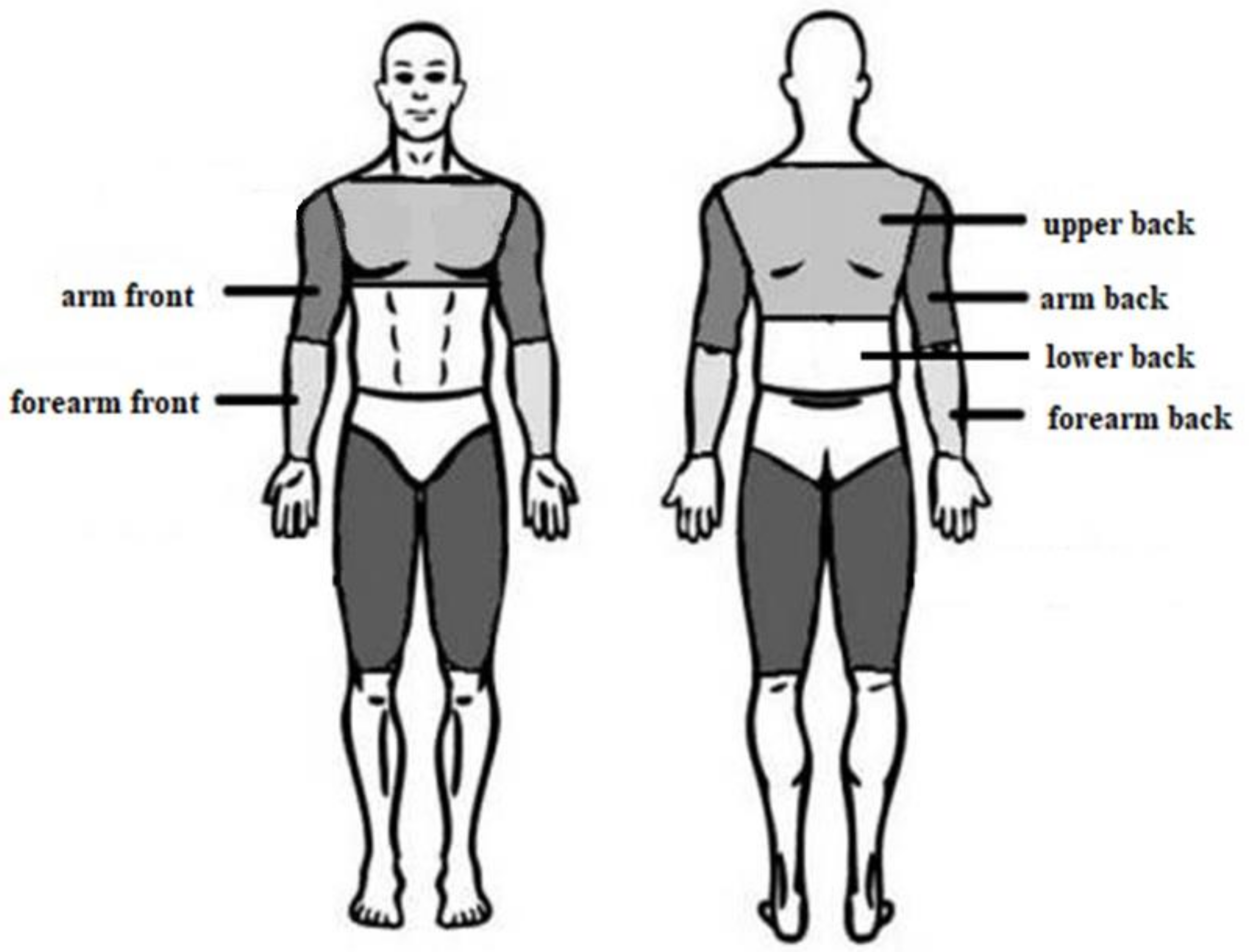

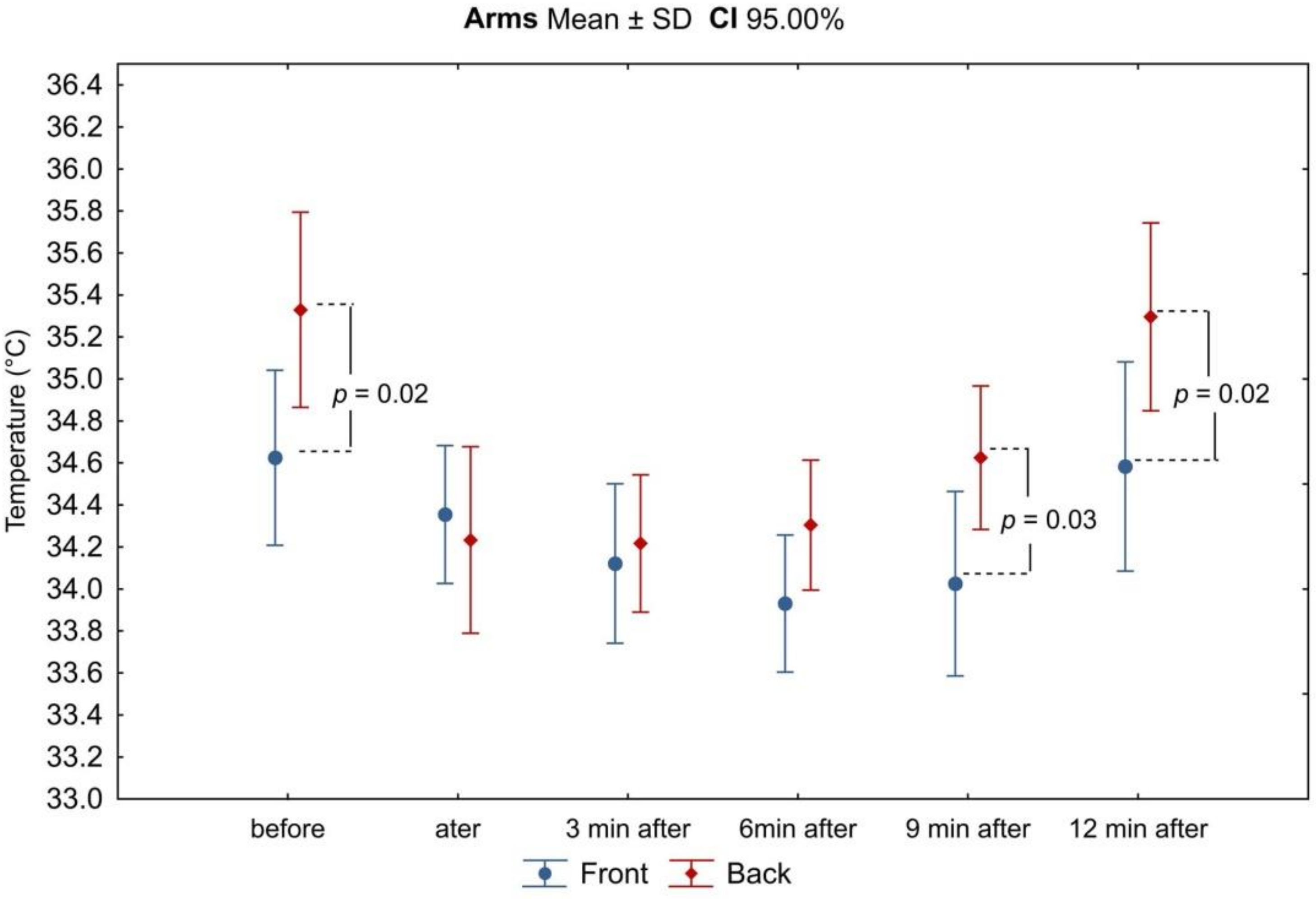
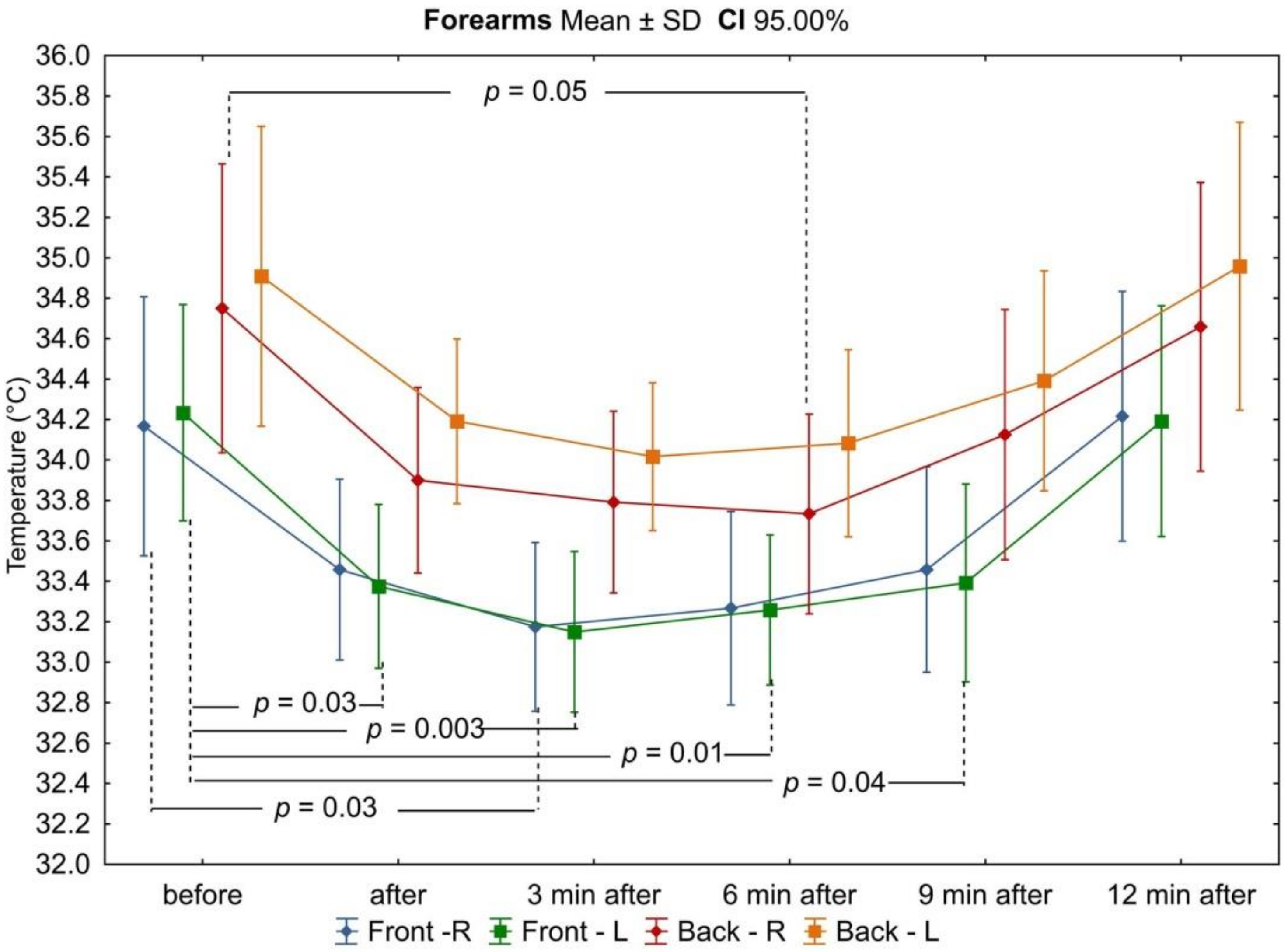
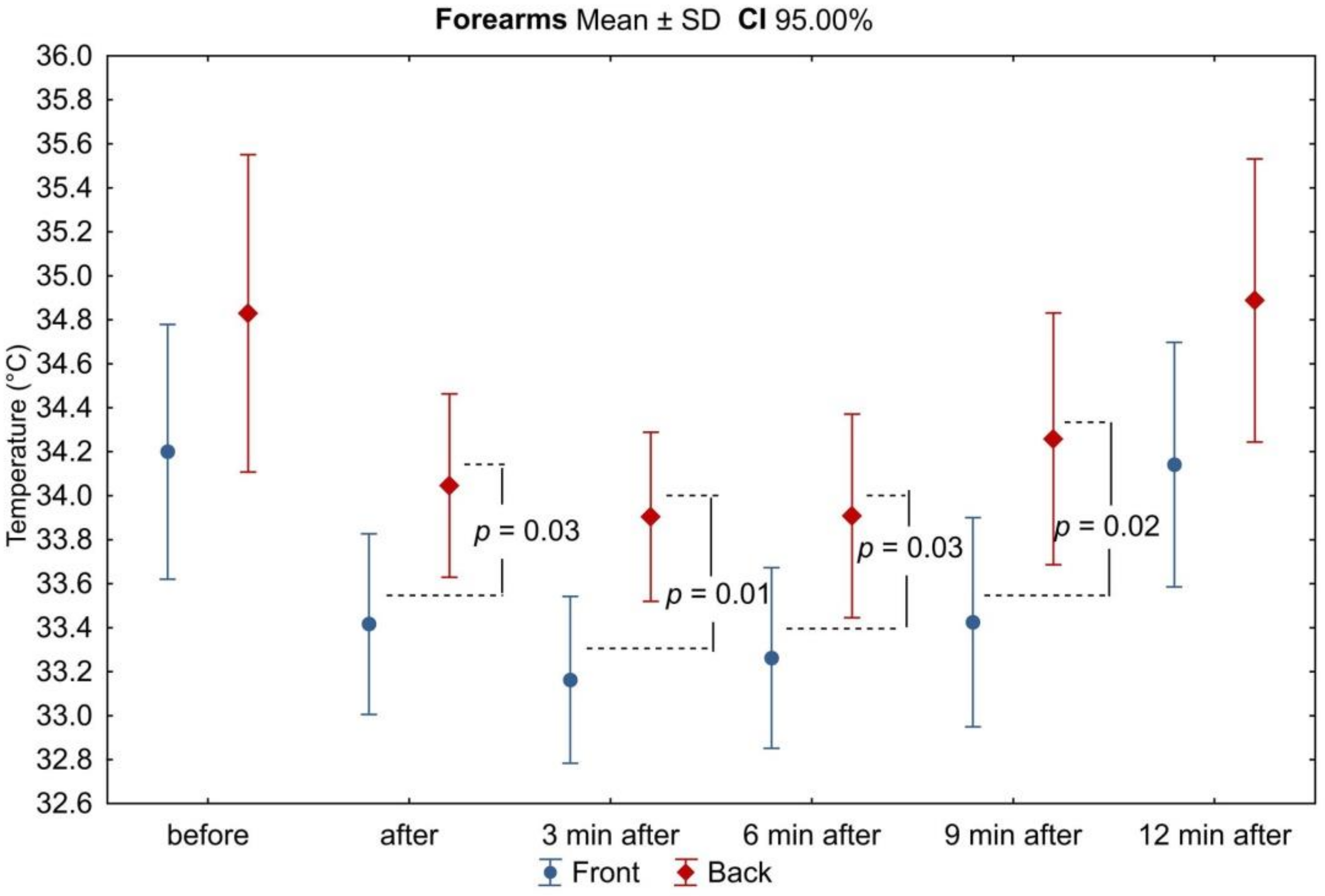
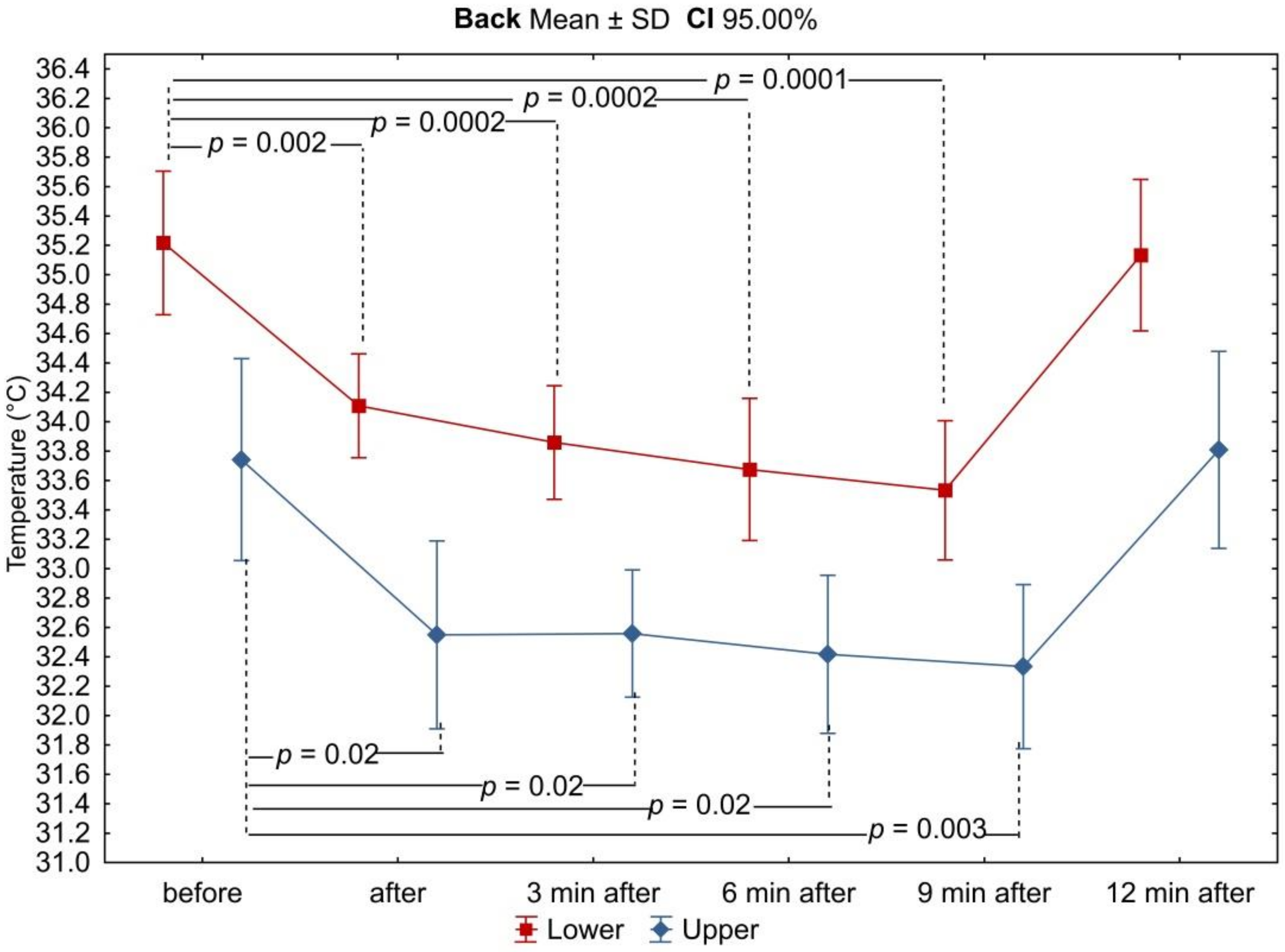
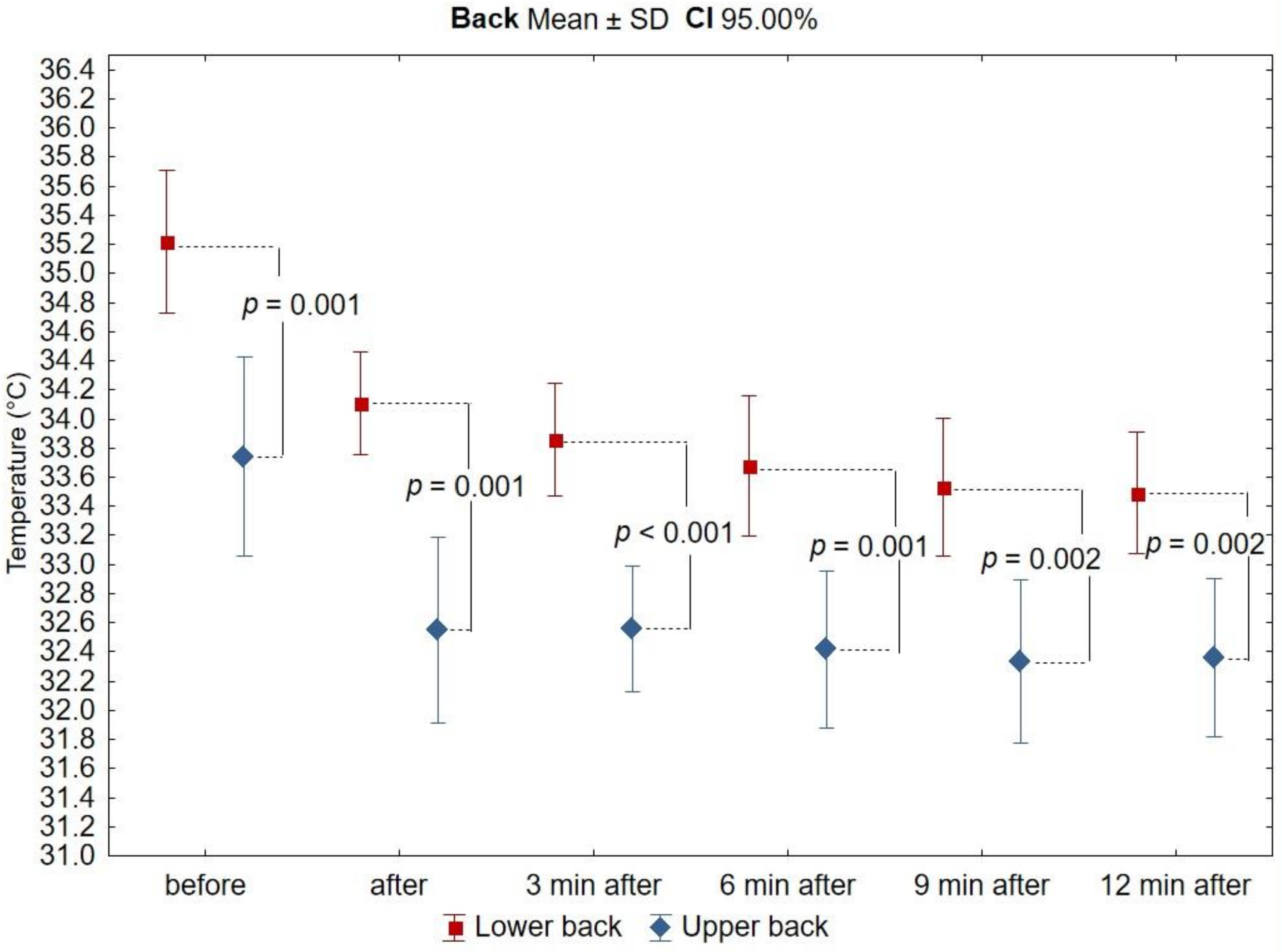
| Body Area | Mean ± SD [°C] | ∆R/L | Student’s t-test p R/L Side | ||||
|---|---|---|---|---|---|---|---|
| Right Side | Left Side | t | p | ||||
| Tbefor | A | front | 34.6 ± 0.66 | 34.7 ± 0.67 | 0.2 ± 0.15 | −0.2454 | 0.8084 |
| back | 35.4 ± 0.77 | 35.3 ± 0.70 | 0.2 ± 0.13 | 0.1932 | 0.8485 | ||
| FR | front | 34.2 ± 1.01 | 34.2 ± 0.84 | 0.3 ± 0.20 | −0.1759 | 0.8620 | |
| back | 34.8 ± 1.13 | 34.9 ± 1.17 | 0.3 ± 0.21 | −0.3383 | 0.7384 | ||
| Tafter | A | front | 34.4 ± 0.54 | 34.3 ± 0.53 | 0.2 ± 0.19 | 0.1909 | 0.8504 |
| back | 34.2 ± 0.67 | 34.3 ± 0.76 | 0.3 ± 0.20 | −0.3404 | 0.7368 | ||
| FR | front | 33.5 ± 0.70 | 33.4 ± 0.64 | 0.3 ± 0.20 | 0.3041 | 0.7639 | |
| back | 33.9 ± 0.72 | 34.2 ± 0.64 | 0.4 ± 0.28 | −1.0467 | 0.3066 | ||
| T3min | A | front | 34.1 ± 0.69 | 34.1 ± 0.55 | 0.3 ± 0.21 | 0.0658 | 0.9482 |
| back | 34.3 ± 0.44 | 34.2 ± 0.62 | 0.2 ± 0.25 | 0.5294 | 0.6019 | ||
| FR | front | 33.2 ± 0.66 | 33.2 ± 0.63 | 0.4 ± 0.27 | 0.0955 | 0.9248 | |
| back | 33.8 ± 0.71 | 34.0 ± 0.57 | 0.3 ± 0.35 | −0.8557 | 0.4014 | ||
| T6min | A | front | 34.0 ± 0.55 | 33.9 ± 0.57 | 0.3 ± 0.17 | 0.2534 | 0.8023 |
| back | 34.2 ± 0.58 | 34.4 ± 0.47 | 0.3 ± 0.28 | −0.7306 | 0.4727 | ||
| FR | front | 33.3 ± 0.75 | 33.3 ± 0.58 | 0.3 ± 0.16 | 0.0303 | 0.9761 | |
| back | 33.7 ± 0.78 | 34.1 ± 0.73 | 0.4 ± 0.32 | −1.1390 | 0.2669 | ||
| T9min | A | front | 34.1 ± 0.64 | 34.0 ± 0.85 | 0.3 ± 0.48 | 0.3265 | 0.7472 |
| back | 34.5 ± 0.62 | 34.7 ± 0.54 | 0.4 ± 0.30 | −0.7030 | 0.4894 | ||
| FR | front | 33.5 ± 0.80 | 33.4 ± 0.77 | 0.4 ± 0.26 | 0.2082 | 0.8370 | |
| back | 34.1 ± 0.97 | 34.4 ± 0.86 | 0.3 ± 0.26 | −0.7129 | 0.4834 | ||
| T12min | A | front | 34.6 ± 0.66 | 34.7 ± 0.67 | 0.2 ± 0.15 | −0.2454 | 0.8084 |
| back | 35.4 ± 0.77 | 35.3 ± 0.70 | 0.2 ± 0.13 | 0.1932 | 0.8485 | ||
| FR | front | 34.2 ± 0.97 | 34.2 ± 0.90 | 0.3 ± 0.20 | 0.0655 | 0.9484 | |
| back | 34.7 ± 1.12 | 35.0 ± 1.12 | 0.3 ± 0.21 | −1.6768 | 0.1077 | ||
| Body Area | Me ± SD [°C] | |||||
|---|---|---|---|---|---|---|
| Tberofe | Tafter | T3min | T6min | T9min | T12min | |
| UB | 33.7 ± 1.08 | 32.6 ± 1.01 | 32.6 ± 0.68 | 32.4 ± 0.85 | 32.3 ± 0.88 | 32.3 ± 0.81 |
| LB | 35.2 ± 0.77 | 34.1 ± 0.56 | 33.9 ± 0.61 | 33.7 ± 0.76 | 33.5 ± 0.75 | 33.5 ± 0.96 |
| Body Area | Mean ± SD [°C] | ANOVA | Power | |||||||
|---|---|---|---|---|---|---|---|---|---|---|
| ΔTbefore–after | ΔTafter—3min | ΔT3–6min | ΔT6–9min | ΔT9–12min | F | p | for α = 0.05 | |||
| Arms | front | R | 0.2 ± 0.78 | 0.3 ± 0.43 | 0.1 ± 0.50 | −0.1 ± 0.53 | −0.5 ± 0.56 | 2.304 | 0.054 | 0.806 |
| L | 0.3 ± 0.74 | 0.2 ± 0.33 | 0.2 ± 0.36 | −0.1 ± 0.53 | −0.7 ± 0.87 | 2.941 | 0.019 | 0.958 | ||
| back | R | 1.2 ± 1.02 | 0.1 ± 0.43 | 0.1 ± 0.27 | −0.3 ± 0.40 | −0.8 ± 0.71 | 8.349 | <0.0001 | 1.000 | |
| L | 1.0 ± 1.01 | 0.1 ± 0.41 | −0.2 ± 0.28 | −0.3 ± 0.37 | −0.6 ± 0.54 | 7.536 | <0.0001 | 0.999 | ||
| Forearms | front | R | 0.7 ± 1.20 | 0.3 ± 0.39 | −0.1 ± 0.43 | −0.2 ± 0.29 | −0.8 ± 0.82 | 3.628 | 0.006 | 0.989 |
| L | 0.9 ± 1.06 | 0.2 ± 0.41 | −0.1 ± 0.51 | −0.1 ± 0.54 | −0.8 ± 0.66 | 5.166 | <0.0001 | 0.998 | ||
| back | R | 0.9 ± 0.77 | 0.1 ± 0.43 | 0.1 ± 0.33 | −0.4 ± 0.44 | −0.5 ± 0.85 | 2.776 | 0.025 | 0.927 | |
| L | 0.7 ± 0.93 | 0.2 ± 0.48 | −0.1 ± 0.45 | −0.3 ± 0.40 | −0.6 ± 0.73 | 2.670 | 0.029 | 0.976 | ||
| Back | upper | 1.2 ± 0.67 | 0.0 ± 0.63 | 0.1 ± 0.47 | 0.1 ± 0.25 | 0.03 ± 0.4 | 4.286 | <0.001 | 0.998 | |
| lower | 1.1 ± 0.69 | 0.3 ± 0.40 | 0.2 ± 0.33 | 0.1 ± 0.46 | 0.04 ± 0.3 | 10.615 | <0.0001 | 1.000 | ||
Publisher’s Note: MDPI stays neutral with regard to jurisdictional claims in published maps and institutional affiliations. |
© 2021 by the authors. Licensee MDPI, Basel, Switzerland. This article is an open access article distributed under the terms and conditions of the Creative Commons Attribution (CC BY) license (https://creativecommons.org/licenses/by/4.0/).
Share and Cite
Knyszyńska, A.; Radecka, A.; Lubkowska, A. Thermal Imaging of Exercise-Associated Skin Temperature Changes in Swimmers Subjected to 2-min Intensive Exercise on a VASA Swim Bench Ergometer. Int. J. Environ. Res. Public Health 2021, 18, 6493. https://doi.org/10.3390/ijerph18126493
Knyszyńska A, Radecka A, Lubkowska A. Thermal Imaging of Exercise-Associated Skin Temperature Changes in Swimmers Subjected to 2-min Intensive Exercise on a VASA Swim Bench Ergometer. International Journal of Environmental Research and Public Health. 2021; 18(12):6493. https://doi.org/10.3390/ijerph18126493
Chicago/Turabian StyleKnyszyńska, Anna, Aleksandra Radecka, and Anna Lubkowska. 2021. "Thermal Imaging of Exercise-Associated Skin Temperature Changes in Swimmers Subjected to 2-min Intensive Exercise on a VASA Swim Bench Ergometer" International Journal of Environmental Research and Public Health 18, no. 12: 6493. https://doi.org/10.3390/ijerph18126493
APA StyleKnyszyńska, A., Radecka, A., & Lubkowska, A. (2021). Thermal Imaging of Exercise-Associated Skin Temperature Changes in Swimmers Subjected to 2-min Intensive Exercise on a VASA Swim Bench Ergometer. International Journal of Environmental Research and Public Health, 18(12), 6493. https://doi.org/10.3390/ijerph18126493







